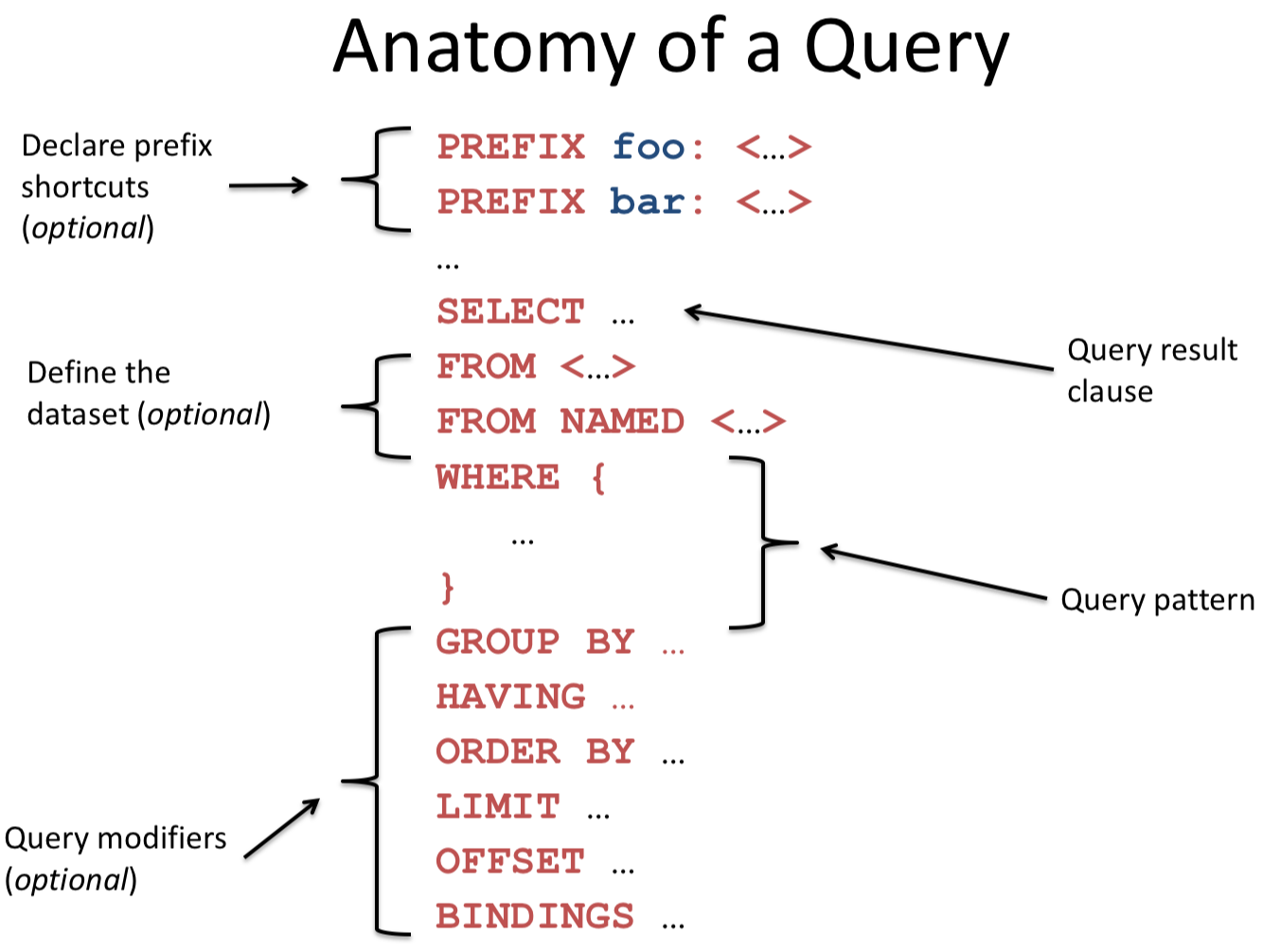DBpedia
DBpedia is a project aiming to extract structured content from the information in Wikipedia. DBpedia allows users to semantically query relationships and properties of Wikipedia resources, including links to other related datasets, using the SPARQL query language. DBpedia stores information in a RDF database.
RDF
RDF (Resource Description Framework) databases are different than typical “spreadsheet” databases as they are in the form of a graph rather than a table. This graph consists of nodes representing objects with directed edges representing relationships between them. The term triple is used to describe any two nodes with an edge connecting them.
Example RDF Graph with 9 triples
 (source https://www.researchgate.net/figure/Example-RDF-graph-containing-9-triples-describing-the-city-of-Leipzig-and-its-mayor_fig2_221510762)
(source https://www.researchgate.net/figure/Example-RDF-graph-containing-9-triples-describing-the-city-of-Leipzig-and-its-mayor_fig2_221510762)
SPARQL
SPARQL (pronounced “sparkle”, short for SPARQL Protocol and RDF Query Language) is a query language used to retrieve and manipulate data stored in RDF format.
Specifics
URIs
Full URI written out
<http://this.is.a/full/URI/written#out>
URI shortened using PREFIX
At the top of your query put:
PREFIX foo: <http://this.is.a/URI/prefix#>
Later on you can type:
foo:bar
And it will translate to:
http://this.is.a/URI/prefix#bar
Literals
Plain literals
"a plain literal"
Plain literal with language tag
"bonjour"@fr
Typed literal
"13"^^xsd:integer
Shortcuts
true -> "true"^^xsd:boolean
3 -> "3"^^xsd:integer
4.2 -> "4.2"^^xsd:decimal
Variables
?var1
?anotherVar
?and_one_more
Comments
# Comments start with a '#'
# continue to the end of the line
Triple patterns
Triple patterns match a node (the subject) and the directed edge (the predicate/relationship) to another node (the object)
The format of a triple is:
[literal/variable for node1] [literal/variable for edge] [literal/variable for node2]
You can put a dot at the end of the line to seperate triples.
Example triple queries
Match an exact RDF triple
ex:myWidget ex:partNumber "XY24Z1" .
Match one variable
?person foaf:name "Lee Feigenbaum" .
Match multiple variables
conf:SemTech2009 ?property ?value .
Query format
A SPARQL query comprises, in order, of:
- Prefix declarations for abbreviating URIs
- Dataset definition stating what RDF graph(s) are being queried
- A result clause identifying what information to return from the query
- The query pattern specifying what to query for in the underlying dataset
- Query modifiers slicing, ordering, and otherwise rearranging results
 (source http://www.iro.umontreal.ca/~lapalme/ift6281/sparql-1_1-cheat-sheet.pdf)
(source http://www.iro.umontreal.ca/~lapalme/ift6281/sparql-1_1-cheat-sheet.pdf)
Important Modifiers
Filter
A boolean condition to reduce the query result
Functions and operators in SPARQL:
- Logical - ||, &&, !
- Comparison - <, >, = !=, IN, NOT IN
- Other - str, lang, datatype, isURI, isBlank, isLiteral, isNumeric, bound, sameTerm, langMatches, regex, REPLACE
Many other functions with SPARQL 1.1
Example - Find all actors born after 1975
SELECT ?person ?birth_year
WHERE {
?person ?rel <http://umbel.org/umbel/rc/Actor> .
?person <http://dbpedia.org/ontology/birthYear> ?birth_year .
FILTER (xsd:integer(xsd:string(?birth_year)) > 1975)
}
In this example the first triple gets anyone connected to the concept of actor. This is joined to the second triple which gets the birth years of the people returned from the first triple. Finally the information is filtered out with ?birth_year being cast to integer as it is of type xsd:year, so it can be compared.
Example DBpedia queries
You can run these queries against DBpedia using the website http://dbpedia.org/snorql/
Get an overview of Kanye West
PREFIX db: <http://dbpedia.org/resource/>
SELECT *
WHERE {
db:Kanye_West ?rel ?obj .
}
Results:
All triples starting at Kanye West.
Find what awards Barack Obama has won
SELECT ?award
WHERE {
<http://dbpedia.org/resource/Barack_Obama> <http://dbpedia.org/ontology/award> ?award .
}
Results:
Nobel_Peace_Prize
Find what US presidents graduated from Harvard University
SELECT ?person
WHERE {
?person ?r1 <http://dbpedia.org/class/yago/WikicatPresidentsOfTheUnitedStates> .
?alumn ?r2 <http://dbpedia.org/class/yago/WikicatHarvardUniversityAlumni> .
FILTER (?person = ?alumn)
}
Results:
Theodore_Roosevelt
Franklin_D._Roosevelt
John_Quincy_Adams
Barack_Obama
Rutherford_B._Hayes
John_Adams
George_W._Bush
John_F._Kennedy